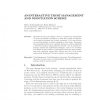Free Online Productivity Tools
i2Speak
i2Symbol
i2OCR
iTex2Img
iWeb2Print
iWeb2Shot
i2Type
iPdf2Split
iPdf2Merge
i2Bopomofo
i2Arabic
i2Style
i2Image
i2PDF
iLatex2Rtf
Sci2ools
IFIP
2004
Springer
2004
Springer
An Interactive Trust Management and Negotiation Scheme
Interactive access control allows a server to compute and communicate on the fly the missing credentials to a client and to adapt its responses on the basis of presented and declined credentials. Yet, it may disclose too much information on which credentials a client needs. Automated trust negotiation allows for a controlled disclosure on which credentials a client has during a mutual disclosure process. Yet, it requires prearranged policies and sophisticated strategies. How do we bootstrap from simple security policies a comprehensive interactive trust management and negotiation scheme that combines the best of both worlds without their limitations? This is the subject of the present paper.
| Added | 02 Jul 2010 |
| Updated | 02 Jul 2010 |
| Type | Conference |
| Year | 2004 |
| Where | IFIP |
| Authors | Hristo Koshutanski, Fabio Massacci |
Comments (0)

